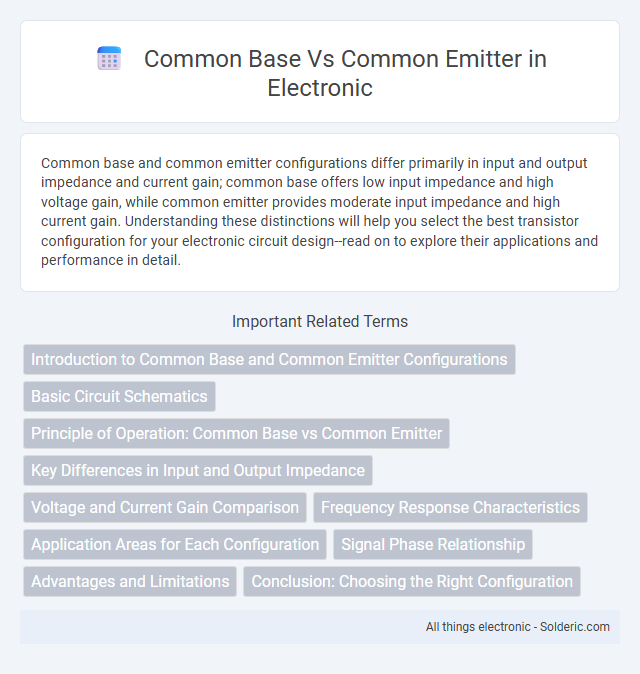Common base and common emitter configurations differ primarily in input and output impedance and current gain; common base offers low input impedance and high voltage gain, while common emitter provides moderate input impedance and high current gain. Understanding these distinctions will help you select the best transistor configuration for your electronic circuit design--read on to explore their applications and performance in detail.
Comparison Table
| Parameter | Common Base (CB) | Common Emitter (CE) |
|---|---|---|
| Input Terminal | Emitter | Base |
| Output Terminal | Collector | Collector |
| Common Terminal | Base | Emitter |
| Current Gain (b) | Less than 1 | High (typically 100) |
| Voltage Gain | High | High |
| Input Impedance | Low (tens of ohms) | Moderate (kilo-ohms) |
| Output Impedance | High | High |
| Phase Relationship (Input to Output) | 0deg (No phase inversion) | 180deg (Phase inversion) |
| Applications | High-frequency amplifiers, impedance matching | General-purpose amplification |
| Typical Frequency Response | High-frequency operation | Moderate frequency operation |
Introduction to Common Base and Common Emitter Configurations
Common base and common emitter configurations are fundamental transistor amplifier setups used in analog electronics. Common base configuration offers low input impedance and high voltage gain, making it ideal for high-frequency applications, while common emitter configuration provides moderate input impedance, high current gain, and significant voltage amplification, widely used for general amplification purposes. Understanding these configurations helps optimize Your circuit design for desired input/output characteristics and gain requirements.
Basic Circuit Schematics
Common base circuits feature the emitter as the input and the collector as the output, with the base terminal serving as a common reference point, often connected to ground. In contrast, common emitter configurations use the base as the input, collector as the output, and the emitter as the common terminal, typically grounded. Your choice between these two depends on desired voltage gain, input impedance, and phase inversion characteristics within transistor amplifier designs.
Principle of Operation: Common Base vs Common Emitter
The common base configuration operates with the input signal applied to the emitter and output taken from the collector, providing low input impedance and high voltage gain, ideal for high-frequency applications. In contrast, the common emitter configuration applies the input signal to the base and takes output from the collector, offering moderate input impedance, significant current and voltage gain, and phase inversion between input and output. Understanding these operational principles helps you choose the right transistor setup for amplification tasks based on impedance and gain requirements.
Key Differences in Input and Output Impedance
The common base configuration exhibits low input impedance, typically ranging from 50 to 200 ohms, making it suitable for high-frequency applications where low reactance is crucial. In contrast, the common emitter configuration features a moderate to high input impedance, often between 1k to 10k ohms, which allows it to better interface with signal sources. Output impedance in the common base setup is relatively high, while the common emitter configuration provides moderate output impedance, enabling greater voltage gain in amplifier circuits.
Voltage and Current Gain Comparison
The common emitter configuration provides high voltage and current gain, making it ideal for amplification purposes, while the common base offers voltage gain with very low current gain, typically less than one. Your choice depends on whether you need substantial current amplification, favoring common emitter, or better high-frequency performance with low input impedance, which common base delivers. Voltage gain in a common emitter stage can often exceed 100, whereas common base voltage gain is moderate, usually between 10 and 50.
Frequency Response Characteristics
Common base amplifiers exhibit superior high-frequency response due to low input capacitance and minimal Miller effect, making them ideal for RF applications. Common emitter configurations suffer from reduced gain at higher frequencies because of increased input capacitance and significant Miller capacitance, which limits bandwidth. Consequently, common base stages are preferred when wide bandwidth and fast response are critical, while common emitter stages are favored for moderate frequency applications with higher voltage gain.
Application Areas for Each Configuration
Common base configuration is frequently used in high-frequency applications such as radio frequency amplifiers and microwave circuits due to its low input impedance and high voltage gain. Common emitter configuration excels in general-purpose amplification tasks in audio amplifiers, switching, and signal processing circuits, offering high current gain and phase inversion. Each configuration is selected based on specific requirements like input/output impedance, gain, and frequency response for optimized performance.
Signal Phase Relationship
In a common base amplifier, the output signal is in phase with the input signal, meaning there is no phase inversion. In contrast, a common emitter amplifier produces an output signal that is 180 degrees out of phase with the input signal, causing a phase inversion. Understanding this signal phase relationship helps you select the appropriate amplifier configuration for your specific circuit requirements.
Advantages and Limitations
Common base amplifiers offer high voltage gain and excellent high-frequency response, making them suitable for RF applications. However, they suffer from low input impedance, which limits their use in circuits requiring signal sources with high impedance. Common emitter amplifiers provide good voltage gain and moderate input impedance, ideal for general-purpose amplification, but they exhibit a phase inversion and lower bandwidth compared to common base configurations.
Conclusion: Choosing the Right Configuration
Common emitter configuration offers high voltage gain and is widely used for amplifying weak signals, making it ideal for general-purpose amplification in audio and RF circuits. Common base configuration provides low input impedance and high-frequency performance, which suits applications requiring wide bandwidth and stability at high frequencies. Your choice depends on the required gain, input impedance, and frequency response for optimal circuit design.
common base vs common emitter Infographic

 solderic.com
solderic.com